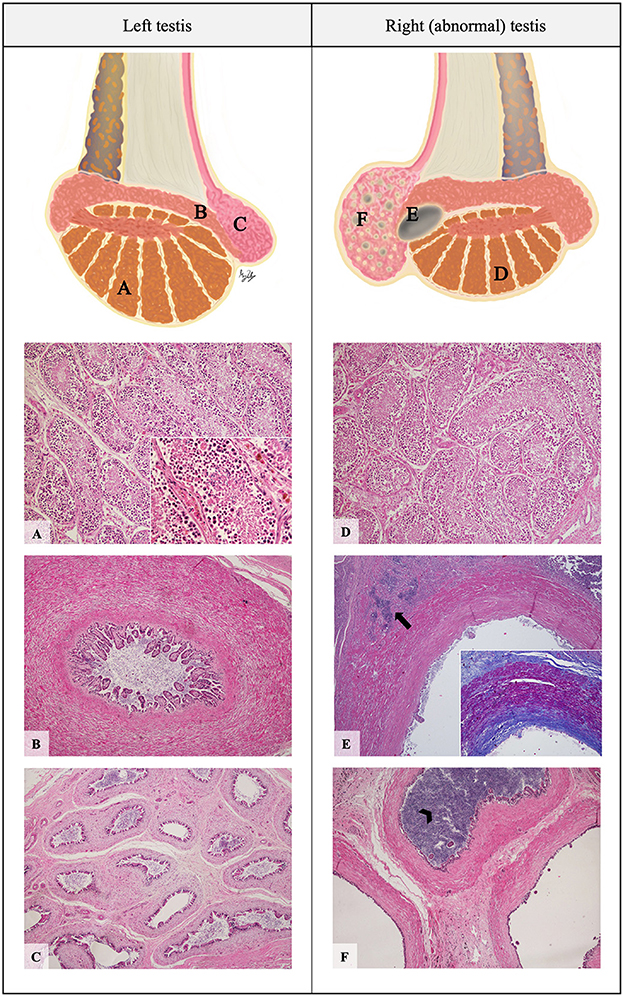35. Disorders of the testes – spermatocele, testicular tumours
1/36
There's no tags or description
Looks like no tags are added yet.
Name | Mastery | Learn | Test | Matching | Spaced |
|---|
No study sessions yet.
37 Terms
What is a spermatocele?
Distension of the epididymis filled with sperm, usually due to a blockage

What can happen when a spermatocele leaks?
Inflammation leading to sperm granuloma
Can a spermatocele be unilateral or bilateral?
Yes
In what type of dogs are spermatoceles typically seen, and how does age affect the risk?
Intact dogs, risk increases with age
What are some potential causes of spermatocele?
Trauma, hyperplasia, or adenomyosis (epididymis lining growth into deeper tissues due to excess oestrogen)
What are the typical clinical signs of spermatocele?
Infertility (pain is rare)
Is spermatocele a gradual or sudden process?
Gradual
How is spermatocele diagnosed?
Testicular examination and palpation, semen evaluation (azoospermia), USG, biopsy
Is there a medical treatment for spermatocele?
No
Is surgery commonly performed for spermatocele?
Rarely
In what age range are testicular tumours most common in dogs?
9-11 years
Which dog breeds have a predisposition for testicular tumours?
Boxers, poodles, and German shepherds
Are testicular tumours common in cats?
Rare
Which types of testicular tumours are most common in cryptorchid testes?
Sertoli cell tumours and seminomas
Which type of testicular tumour is most common in scrotal testes?
Leydig cell tumours
What are some general clinical signs of testicular tumours?
Large/asymmetric testicles, scrotal enlargement, infertility, penile atrophy, atrophy of the unaffected testicle, pendulous prepuce, dyspnoea (if lung metastasis)
What cytological finding might suggest a Sertoli cell tumour?
Anuclear cells (due to increased oestrogen)
What diagnostic tests are used for testicular tumours?
Cytology, semen evaluation, USG, testicular aspiration or biopsy, histopathology, blood count and chemistry, thoracic X-ray
What are the treatment options for inoperable testicular tumours?
Chemotherapy (cisplatin, vinblastine)
What is the recommended surgical treatment for testicular tumours?
Unilateral castration (breeding animal) or bilateral castration (best)
What is the most common type of testicular tumour in dogs?
Sertoli cell tumour
What hormone does a Sertoli cell tumour typically secrete?
Oestrogen
What are some clinical signs associated with hyperoestrogenism due to a Sertoli cell tumour?
Feminization, attraction of other male dogs, bone marrow suppression (panleukopenia + anaemia), symmetrical alopecia
What is the malignant potential of seminomas?
50/50 benign or malignant, with a higher chance of metastasis compared to Sertoli cell tumours
Do seminomas typically secrete hormones?
No
Which dog breed has a predisposition for seminomas?
German Shepherds
What hormones can Leydig cell tumours secrete?
Oestrogen and testosterone
Are Leydig cell tumours typically benign or malignant?
Benign
What is a common characteristic of Leydig cell tumours upon examination?
Small and soft
What is adenomyosis in the context of the epididymis?
Invasion of the epididymis lining cells into the muscular layers, potentially caused by excess oestrogen.
What does azoospermia mean?
The absence of sperm in the semen, a potential finding with spermatocele.
What is a sperm granuloma?
A nodule of tissue that develops due to inflammation caused by leaked sperm from a spermatocele.
What is a pendulous prepuce?
A prepuce that hangs down more noticeably than normal, sometimes seen with testicular tumours.
What is dyspnoea?
Difficulty breathing, a sign that might occur if a testicular tumour has metastasized to the lungs.
What is panleukopenia?
A decrease in the number of white blood cells, which can be a sign of bone marrow suppression due to a Sertoli cell tumour.
What is non-regenerative anaemia?
Anaemia where the bone marrow is not producing enough new red blood cells, potentially caused by a Sertoli cell tumour.
What is thrombocytopenia?
A decrease in the number of platelets in the blood, another potential sign of bone marrow suppression from a Sertoli cell tumour.